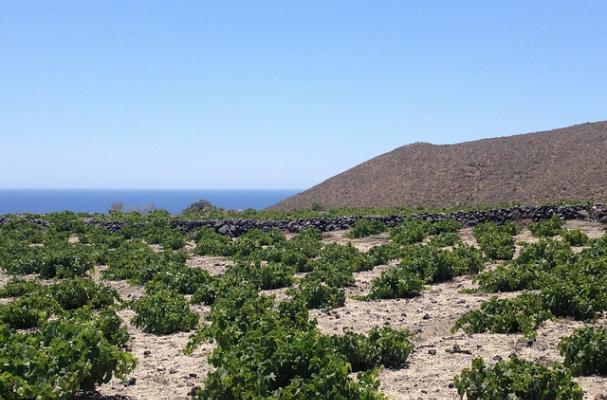
One of the first things you'll notice when looking at Assyrtiko vines on the Greek Island of Santorini is, well, they don't much look like typical grape vines. The haphazardly-spaced and shrub-like vines are a far cry from the manicured, orderly vineyards you are used to seeing:

But there is a hidden beauty in these vines that makes the white wines crafted from the native Assyrtiko grape one of the most remarkable stories in the history of wine. The climate on the island of Santorini is, to put it mildly, pretty unforgiving, especially for grape-growing. Unrelenting sun, soul-crushing heat, and fierce winds all combine to make for seemingly insurmountable odds for success in the vineyards. So how do you end up with a bottle of Assyrtiko in your hands? Well, when you look deeper, there is a lot of magic and ingenuity happening.
But before you can look deeper, you need to realize that you are standing in a vineyard. Due to its unfamiliar look and spacing it would be pretty easy to fail to notice or drive by the vineyard you see pictured at the top. If we didn't have Yiannis Paraskevopoulos of Gaia Wines escorting us there, we might have suffered the same fate. (My visit to Santorini was for a press trip sponsored by Wines from Santorini.)
 Here's a close-up look of an Assyrtiko vine. They are actually woven into a basket and the grapes (you can see a bunch hiding behind the vines), grown on the inside, are protected from the wind and sun. (And also from blowing volcanic soil that would scour the grapes like sandpaper being shot out of a cannon.) These vines are over 100 years old and the roots are centuries old. It's hard not to be among them and be a bit awestruck by the vines, the terrain, the ocean view, and the words of Yiannis: "We are standing in the oldest, most historic, producing vineyard in the world." Not only was everybody on this trip fascinated by the vines, but we all shared a keen interest in getting winemakers to pose with them:
Here's a close-up look of an Assyrtiko vine. They are actually woven into a basket and the grapes (you can see a bunch hiding behind the vines), grown on the inside, are protected from the wind and sun. (And also from blowing volcanic soil that would scour the grapes like sandpaper being shot out of a cannon.) These vines are over 100 years old and the roots are centuries old. It's hard not to be among them and be a bit awestruck by the vines, the terrain, the ocean view, and the words of Yiannis: "We are standing in the oldest, most historic, producing vineyard in the world." Not only was everybody on this trip fascinated by the vines, but we all shared a keen interest in getting winemakers to pose with them:

Clockwise from top left you're looking at Yiannis, Paris Sigalas from Domaine Sigalas, and George Koutsoyiannopoulos from Koutsoyiannpoulos Winery. All three produce white wines made from Assyrtiko; not only are the vines astonishing, but so are the wines. Probably the most notable attribute of Assyrtiko is its natural acidity. Usually grapes grown in such intense heat would produce a white wine with little natural zip, but Assyrtiko has it in spades. It is a very lively white wine. Assyrtiko also has quite a bit of a sea-breeze quality to it; no doubt from the grapes being literally touched by sea breezes and condensation from from fog coming off the the ocean. And the volcanic soils lend some of that elusive quality know as "minerality" to Assyrtiko. (It's a kind of wet-stone-in-a-mountain-stream quality that makes the it such a lovely wine with seafood and shellfish. As Yiannis proclaimed, "Nature has created oysters for this wine.")
Though most bottles of Assyrtiko are unoaked--and I encourage you to try these unoaked versions to start--winemakers are also experimenting with barrel-aging in oak for extra texture, richness, and flavor. Yiannis, who uses oak in his Wild Ferment Assyrtiko, does, however, raise caution about its use: "The moment you start fiddling with wood you are walking away from the hard-core typicity." I enjoyed sampling versions with oak as they tamed the aggressiveness of the Assyrtiko, and were an interesting way to show the versatility of the grape.
And while unoaked Assyrtiko is a natural with the hot, blazing sun and cuisine of seafood and vegetables, this is not to say it is a simple summer sipper. These are wines that can improve with age. Yiannis recommends a half-hour in a decanter before enjoying your Assyrtiko; he advises to "treat these wines as red [wine] without color." I have to say my impatient nature, especially when confronted with a bottle of Assyrtiko, a Greek salad with astoundingly good feta, and some impeccably fresh seafood with a squeeze of lemon, sometimes precludes me from decanting, but take note of how the wine changes as it is open for a while and warms up a bit in your glass.

But if you're not hungry, and share my hastiness when it comes to opening and sipping a well-chilled bottle of white wine, all you really need to enjoy Assyrtiko is a shady spot in Santorini to soak in the astonishing views, full of copious amounts of bright white and blue colors. Or, if you're enjoying it in any other part of the world, take comfort in Assyrtiko's transportive flavors. This is truly a wine with a sense of place, and one that you can taste in your glass.
If you'd like a few more sips of Greek wine, see my interview with Yiannis conducted in Seattle earlier this year.










